David Rose has an article in the Sunday Mail yesterday, which I provided the research for. The top article is about the dispute between Bob Ward and Professor Richard Tol.
David Rose asked me to compare the WGII SPM with the chapters. I found a number of discrepancies, which are written up in the paper, and do much (in my view) to support Professor Tol’s claim that the report’s alarmist tone was largely groundless.
The IPCC have responded to the article. The statement takes issue with Tol, first, and then seems to address the discrepancies I have found… But doesn’t.
The Mail on Sunday also quotes some passages from the Working Group II Summary for Policymakers on migration and refugees, wars and conflicts, famine, and extreme weather, which it claims are “sexed up” from statements in the underlying report. In doing so it misleads the reader by distorting the carefully balanced language of the document.
Which document was written in ‘delicately balanced’ language — the SPM or the chapters? And how was this fragile balance ‘distorted’ by the article? The SPM’s language certainly wasn’t balanced. It was unequivocal in many cases. But the language in the chapters told a different story.
For instance, the Mail on Sunday quotes the Summary as saying climate change will ‘increase risks of violent conflicts’. In fact the Summary says that climate change can indirectly increase risks of violent conflicts by amplifying factors such as poverty and economic shocks.
Here is what the article said:
WGII SPM, Page 20:
Climate change can indirectly increase risks of violent conflicts in the form of civil war and inter-group violence by amplifying well-documented drivers of these conflicts such as poverty and economic shocks (medium confidence). Multiple lines of evidence relate climate variability to these forms of conflict.
The SPM links to WGII Chapters 12.5, 13.2, and 19.4.
SPM chapter 12 is concerned with “human security”. Section 12.5 is concerned with “Climate change and Armed Conflict”. I found the chapter to be quite sober, in contrast to the SPM. For e.g.
There is a specific research field that explores the relationship between large-scale disruptions in climate and the collapse of past empires. Relationships are explored using statistical analysis and data derived from archaeological and other historical records. For example, the timing of the collapse of the Khmer empire in the Mekong basin in the early 15th century corresponds to an unusually severe prolonged drought (Buckley et al., 2010). DeMenocal (2001) summarizes evidence that suggests that major changes in weather patterns coincided with the collapse of several previously powerful civilizations, including the Anasazi, the Akkadian, Classic Maya, Mochica, and Tiwanaku empires. Other historical reference points of the interaction of climate with society emerge from analysis of the little Ice Age. Some studies show that the Little Ice Age in the mid 17th century was associated with more cases of political upheaval and warfare than in any other period (Parker 2008, Zhang et al., 2011), including in Europe (Tol and Wagner 2010), China (Brook 2010), and the Ottoman empire (White 2011b). These studies all show that climate change can exacerbate major political changes given certain social conditions, including a predominance of subsistence producers, conflict over territory, and autocratic systems of government with limited power in peripheral regions. The precise causal pathways that link these changes in climate to changes in civilizations are not well understood due to data limitations. Therefore, it should be noted that these findings from historical antecedents are not directly transferrable to the contemporary globalized world. The literature urges caution in concluding that mean future changes in climate will lead to large-scale political collapse (Butzer 2012).
That is an unequivocal statement of caution. And the measured tone continues:
Most of the research on the connections between climate change and armed conflict focuses on the connections between climate variability and intrastate conflicts in the modern era. For the most, part this research examines rainfall or temperature variability as proxies for the kinds of longer-term chances that might occur due to climate change. Several studies examine the relationship between short-term warming and armed conflict (Burke et al., 2009; Buhaug 2010; Koubi et al., 2012; Theisen et al., 2012; O’Loughlin et al., 2012). Some of these find a weak relationship, some find no relationship, and collectively the research does not conclude that there is a strong positive relationship between warming and armed conflict (Theisen et al., 2013).
Still the chapter is advising that we should be careful about linking climate change to armed conflict.
The large majority of studies focuses on Africa and use satellite-enhanced rainfall data collected since 1980. A global study by Hsiang et al. (2011) considers changes in climate over multiple years, and finds that since 1950 and in countries that are affected by ENSO the risk of war within countries rises during an ENSO period. This study is supported by some studies that find associations between deviations in rainfall and civil war (Miguel et al., 2004; Hendrix and Glaser 2007; Hendrix and Salehyan 2012; Raleigh and Kniveton 2012), but contradicted by others that find no significant association between droughts and floods and civil war (Buhaug 2010; Buhaug and Theisen 2012; Koubi et al. 2012; Theisen et al. 2012; Slettebak 2012). There is high agreement that in the specific circumstances where other risk factors are extremely low (such as where per capita incomes are high, and states are effective and consistent), the impact of changes in climate on armed conflict is negligible (Bernauer et al., 2012; Koubi et al., 2012; Scheffran et al., 2012a; Theisen et al., 2013).
I have quoted nearly all of 12.5. It is immediately followed by Box 12-5. Climate and the Multiple Causes of Conflict in Darfur (page 16):
Climate variability or climate change are popularly reported to be significant causes of the mass killing in the Darfur region that began in 2003 (see Mazo, 2009). Five detailed studies dispute the identification of the Darfur conflict as being primarily caused by climate change (Kevane and Gray, 2008; Brown, 2010; Hagen and Kaiser, 2011; Sunga, 2011; Verhoeven, 2011).
All studies of this conflict agree that it is not possible to isolate any of these specific causes as being most influential (Kevane and Gray, 2008; Hagen and Kaiser, 2011; Sunga, 2011; Verhoeven, 2011). Most authors identify government practices as being far more influential drivers than climate variability, noting also that similar changes in climate did not stimulate conflicts of the same magnitude in neighboring regions, and that in the past people in Darfur were able to cope with climate variability in ways that avoided large scale violence.
I’m still not getting how the SPM got to its concern about “amplifying well-documented drivers of these [armed] conflicts such as poverty and economic shocks”.
But, on the other hand, the IPCC does identify in 12.5.2 much more clearly that climate change mitigation can cause conflict:
Research is beginning to show that climate change mitigation and adaptation actions can increase the risk of armed conflict, as well as compound vulnerabilities in certain populations (Bumpus and Liverman, 2008; Adger and Barnett, 2009; Webersik, 2010; Fairhead et al., 2012; Marino and Ribot, 2012; Steinbruner et al., 2012). This is based on robust evidence that violent political struggles occur over the distribution of benefits from natural resources (Peluso and Watts, 2001). Hence, in circumstances where property rights and conflict management
institutions are ineffective or illegitimate, efforts to mitigate or adapt to climate change that change the distribution of access to resources have the potential to create and aggravate conflict.
The attempts to create a link between climate change and conflict have been made for obvious reasons: it would help to sell the idea of the world descending to hell, and sell the climate change agenda to security agencies. But it is at best a contested claim that climate even has a trivial influence over conflict. The IPCC’s rebuttal that climate change can “amplify” the “well-documented drivers of conflicts such as poverty and economic shocks” is equally bogus. It appears to me to be a weaselly way of trying to sustain a link between climate change and conflict no matter what the evidence says, through truisms. But even if it were true that climate change could “amplify” “poverty” and “economic shock” we are no better informed about the degree of amplification for any given amount of global warming. And then there is the problem of identifying the extent to which conflicts have been “driven” by poverty and economic shocks, amplified or not. Moreover, if climate change is a problem which “amplifies” poverty, then the problem is still fundamentally poverty, not climate.
The IPCC’s rebuttal continues:
The Mail on Sunday says the Summary warns of negative impacts on crop yields, with warming responsible for lower yields of wheat, maize, soya and rice. In fact the Summary says that negative impacts of climate change on crop yields have been more common than positive impacts, with wheat and maize yields negatively affected in many regions and effects on rice and soybean yields smaller in major production regions.
The article says:
The SPM said:
Based on many studies covering a wide range of regions and crops, negative impacts of climate change on crop yields have been more common than positive impacts (high confidence). The smaller number of studies showing positive impacts relate mainly to highlatitude regions, though it is not yet clear whether the balance of impacts has been negative or positive in these regions (high confidence). Climate change has negatively affected wheat and maize yields for many regions and in the global aggregate (medium confidence). Effects on rice and soybean yield have been smaller in major production regions and globally, with a median change of zero across all available data, which are fewer for soy compared to the other crops. Observed impacts relate mainly to production aspects of food security rather than access or other components of food security. See Figure SPM.2C. Since AR4, several periods of rapid food and cereal price increases following climate extremes in key producing regions indicate a sensitivity of current markets to climate extremes among other factors (medium confidence).
The IPCC’s statement of the SPM line does nothing to address the problems identified by our article. The SPM is designed to give the reader the impression that crop yields and crop production have fallen. But neither are true. Over the years since AR4, the claim has come up time and time again. And we’ve been able to check claims against the UN’s own statistics.
The IPCC complains that the Mail on Sunday article has misled. But it’s a funny kind of world in which it is known that “negative impacts of climate change on crop yields have been more common than positive impacts”, and yet yields per acre and in total have increased. The IPCC’s WGII SPM was intended to mislead — to give the impression that yields were falling because of climate change.
SEction 7.2.1 points out that
…Formal detection of impacts requires that observed changes be compared to a clearly specified baseline that characterizes behaviour in the absence of climate change…
And that
Attribution of any observed changes to climate trends are further complicated by the fact that models linking climate and agriculture must, implicitly or explicitly, make assumptions about farmer behaviour. […]In most cases, models implicitly assume that farming practices or technologies did not adjust in response to climate over the period of interest.
So in order to make the claim that “negative impacts of climate change on crop yields have been more common than positive impacts”, the IPCC — or the studies they have reviewed — have had to assume:
* That food producers are stupid.
* That a world without climate change would have been more fertile than the one we live in.
There is a very real possibility that the counterfactual scenario allows researchers to pass their premise off as a conclusion: if you assume that a world with climate change is less productive than a world without it, then, surprise surprise, when you compare a counterfactual statistic to a real world statistic, you get a result that reflects your assumptions. Either way, the world is still more productive than it ever has been, thanks in large part to the substances which are blamed for causing climate change. It would be difficult to imagine the following scenarios in a world without tractors, let alone fertiliser produced from natural gas:
Readers may want to investigate further why a lead author of the chapter in which these claims are made enjoyed so many citations:
Lobell, D. and M. B. Burke, 2008: Why are agricultural impacts of
climate change so uncertain? The importance of temperature relative to
precipitation. Environmental Research Letters, 3, 034007.
Lobell, D. B. and M. B. Burke, 2010: On the use of statistical models
to predict crop yield responses to climate change. Agricultural and
Forest Meteorology, 150, 1443-1452.
Lobell, D. B.and C. B. Field, 2007: Global scale climat-crop yield
relationships and the impacts of recent warming. Environmental
Research Letters, 2.
Lobell, D. B. and C. B. Field, 2012: California perennial crops in a
changing climate. Climatic Change, 109, 317-333
Lobell, D., Ortiz-Monasterio, J. 2007. Impacts of day versus night
temperatures on spring wheat yields. 2007. Agronomy Journal 99,
469-477
Lobell, D.B., Sibley, A. and Ortiz-Monasterio, J.I., 2012. Extreme
heat effects on wheat senescence in India. Nature Climate Change,
2(3): 186-189.
Lobell, D. B., U. L. C. Baldos and T. W. Hertel, 2013: Climate
adaptation as mitigation: the case of agricultural investments.
Environmental Research Letters, 8. doi10.1088/1748-9326/8/1/015012.
Lobell, D.B., Hammer, G.L., McLean, G., Messina, C., Roberts, M.J. and
Schlenker, W., 2013. The critical role of extreme heat for maize
production in the United States. Nature Climate Change, 3: 497-501
Lobell, D. B. , J. I. Ortiz-Monasterio, G. P. Asner, P. A. Matson, R.
L. Naylor and W. P. Falcon, 2005: Analysis of wheat yield and climatic
trends in Mexico. Field Crops Research, 94, 250-256.
Lobell, D.B., Schlenker, W. and Costa-Roberts, J., 2011. Climate
Trends and Global Crop Production Since 1980. Science, 333(6042):
616-620.
Lobell, D.B., Banziger, M., Magorokosho, C. and Vivek, B., 2011.
Nonlinear heat effects on African maize as evidenced by historical
yield trials. Nature Clim. Change, 1(1): 42-45.
Lobell, D.B., M.B. Burke, C. Tebaldi, M.D. Mastrandrea, W.P. Falcon,
and R.L. Naylor, 2008: Prioritizing Climate Change Adaptation Needs
for Food Security in 2030. Science, 319, 607-610.Ainsworth, E.A. and J.M. McGrath, 2010: Direct effects of rising
atmospheric carbon dioxide and ozone on crop yields. In: Climate
Change and Food Security: adapting agriculture to a warmer world.
[Lobell, D. and M. Burke(eds.)]. Springer, pp. 109-130.
Burke, M.B., D.B. Lobell, and L. Guarino, 2009: Shifts in African Crop
Climates by 2050, and the Implications for Crop Improvement and
Genetic Resources Conservation. Global Environmental Change, 19,
317-325.
Hertel, T.W., M.B. Burke, and D.B. Lobell, 2010: The poverty
implications of climate-induced crop yield changes by 2030. Global
Environmental Change, 20, 577-585.
The IPCC is in no position to speak about misleading people about the possibility of reduced food yields.
Its rebuttal continues:
The references to the underlying report cited by the Mail on Sunday in contrast to the Summary for Policymakers also give a completely misleading and distorted impression of the report through selective quotation. For instance the reference to “environmental migrants” is a sentence describing just one paper assessed in a chapter that cites over 500 papers – one of five chapters on which the statement in the Summary for Policymakers is based.
The article said:
The SPM said:
Climate change over the 21st century is projected to increase displacement of people (medium evidence, high agreement). Displacement risk increases when populations that lack the resources for planned migration experience higher exposure to extreme weather events, in both rural and urban areas, particularly in developing countries with low income. Expanding opportunities for mobility can reduce vulnerability for such populations. Changes in migration patterns can be responses to both extreme weather events and longer-term climate variability and change, and migration can also be an effective adaptation strategy. There is low confidence in quantitative projections of changes in mobility, due to its complex, multi-causal nature.
It is worth recalling the UN’s previous prediction of 50 Million climate refugees. Wattsupwiththat had a fun and empirical post on the subject back in 2011 at http://wattsupwiththat.com/2011/04/15/the-un-disappears-50-million-climate-refugees-then-botches-the-disappearing-attempt/
This is the ENTIRE section on migration from chapter 9.
9.3.3.3.1. Migration
It is difficult to establish a causal relationship between environmental degradation and migration (see Section 12.4.1). Many authors argue that migration will increase during times of environmental stress (e.g. Afifi, 2011; Gray and Mueller, 2012; Kniveton et al., 2011; Brown and Crawford, 2008), and will lead to an increase in abandonment of settlements (McLeman, 2011). Climate variability has been associated with rural-urban migration (Mertz et al., 2011; Parnell and Walawege, 2011). Another body of literature argues that migration rates are no higher under conditions of environmental or climate stress (Black et al., 2011a and b; van der Geest, 2011; van der Geest and de Jeu, 2008; Tacoli, 2009; McLeman and Hunter, 2010; Gemenne, 2011; Foresight, 2011; Cohen, 2004; Brown, 2008). For Tacoli (2009) the current alarmist predictions of massive flows of so-called “environmental refugees” or “environmental migrants”, are not supported by past experiences of responses to droughts and extreme weather events and predictions for future migration flows are tentative at best. Analogies with past migration experiences are used frequently in such studies (McLeman and Hunter 2010). For example, in Ghana the causality of migration was established to be relatively clear in the case of sudden-onset environmental perturbations such as floods, whereas in case of slow-onset environmental deterioration, there was usually a set of overlapping causes – political and socioeconomic factors – which come into play (van der Geest, 2011). Similarly, a recent survey by Mertz et al. (2010) has argued that climate factors played a limited role in past adaptation options of Sahelian farmers. Given the multiple drivers of migration (Black et al., 2011a and b) and the complex interactions which mediate migratory decision-making by individual or households (Raleigh, 2008; McLeman and Smit, 2006; Kniveton et al., 2011; Black et al., 2011a and b), the projection of the effects of climate change on intra-rural and rural-to-urban migration remains a major challenge.
Chapter 12, section 12.4 (pg 15) states:
There is widespread agreement in the scientific and legal literature that the use of the term climate refugee is scientifically and legally problematic (Taccoli, 2009; Piguet, 2010; Black et al., 2011a; Gemenne, 2011; Jakobeit and Methmann 2012; Bettini, 2013; Piguet, 2013). McAdam calls the concept ‘erroneous as a matter of law and conceptually inaccurate’ (McAdam, 2011, p. 102). The reasons are threefold. First, most migration and climate studies point to the environment as triggers and not causes for migration decisions. Second, some studies focus on the negative geo-political implications of changing the Geneva Convention on refugees to include environmental migrants as well as the lack of global instruments to handle internal displaced peoples or international migrants (Martin, 2009; Cournil, 2011). Third, many small island countries are reluctant themselves to have their international migrants designated as being victims of climate change (McNamara and Gibson, 2009; Farbotko, 2010; Barnett and O’Neill, 2011; Farbotko and Lazrus, 2012).
There were not 500 studies cited by the IPCC WGII in relation to migration as a consequence of climate change. Worse, the chapters explicitly contradict the SPM in more than one chapter. And in fact, rather than depending on just one paper (out of 500), the article quotes from two different chapters’ own conclusions about the range of literature.
A simple keyword search shows many references to publications and statements in the report showing the opposite conclusion, and supporting the statement in the Summary that “Climate change can indirectly increase risks of violent conflicts in the form of civil war and inter-group violence…”
The implication here seems to be that there are lots of other papers, cited throughout the chapters, which support the SPM’s claims. If it’s true, it is the IPCC’s problem. I checked the SPM’s claims against the chapter references cited in the SPM. Moreover, if the evidence considered by the WGII is contradictory, the contradictory nature of the evidence should be reflected in the SPM. It wasn’t. We don’t need to think very deeply about why such an evaluation of the evidence was omitted.
The IPCC have misled people with the WGII SPM. And it has furthermore misled people about the criticism of the SPM.
More results from the research will be published soon.

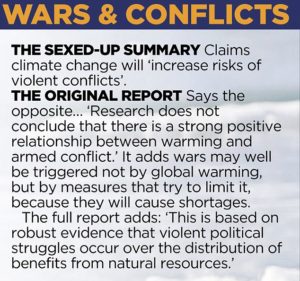
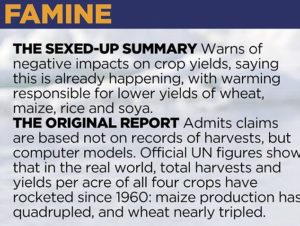
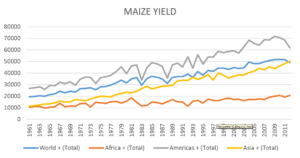
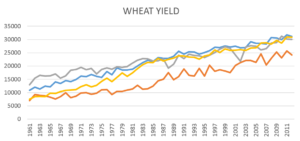
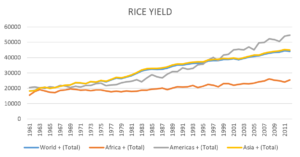
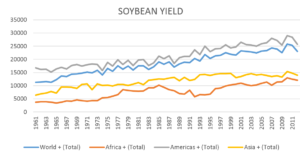
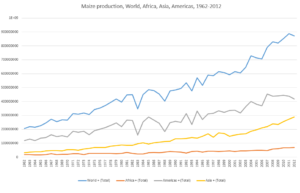
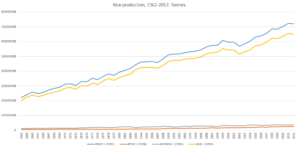
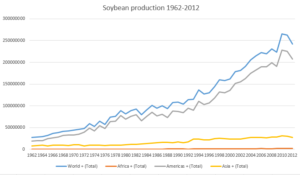
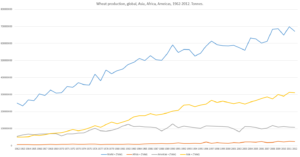
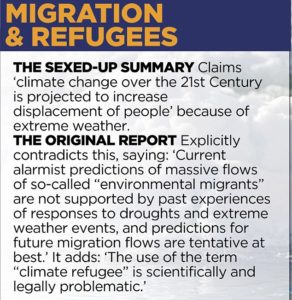
This looks enormous fun Ben, thank you.
“The Large Print Giveth, the Small Print Taketh Away.”
We see again a familiar pattern in this round of IPCC releases, this time the WGII SPM and Report. As previously, the SPM features alarming statements, which are then second-guessed (undermined) by the actual science imbedded in the report details.
For example, I looked the topic of ocean acidification and fish productivity. The SPM asserts on Page 17 that fish habitats and production will fall and that ocean acidification threatens marine ecosystems.
WGII Report, Chapter 6 covers Ocean Systems. There we find more nuance and objectivity:
“Few field observations conducted in the last decade demonstrate biotic responses attributable to anthropogenic ocean acidification” pg 4
“Due to contradictory observations there is currently uncertainty about the future trends of major upwelling systems and how their drivers (enhanced productivity, acidification, and hypoxia) will shape ecosystem characteristics (low confidence).” Pg 5
“Both acclimatization and adaptation will shift sensitivity thresholds but the capacity and limits of species to acclimatize or adapt remain largely unknown” Pg 23
“Production, growth, and recruitment of most but not all non-calcifying
seaweeds also increased at CO2 levels from 700 to 900 µatm Pg 25
“Contributions of anthropogenic ocean acidification to climate-induced alterations in the field have rarely been established and are limited to observations in individual species” Pg. 27
“To date, very few ecosystem-level changes in the field have been attributed to anthropogenic or local ocean acification.” Pg 39
I am finding much more credible the Senate Testimony of John T. Everett, in which he said:
“There is no reliable observational evidence of negative trends that can be traced definitively to lowered pH of the water. . . Papers that herald findings that show negative mpacts need to be dismissed if they used acids rather than CO2 to reduce alkalinity, if they simulated CO2 values beyond triple those of today, while not reporting results at concentrations of half, present, double and triple, or as pointed out in several studies, they did not investigate adaptations over many generations.”
“In the oceans, major climate warming and cooling and pH (ocean pH about 8.1) changes are a fact of life, whether it is over a few years as in an El Niño, over decades as in the Pacific Decadal Oscillation or the North Atlantic Oscillation, or over a few hours as a burst of upwelling (pH about 7.59-7.8) appears or a storm brings acidic rainwater (pH about 4-6) into an estuary.”
Ben, there’s stuff in Chapter 19 to justify the SPM’s statement about increased displacement of people. 19.4.2.1.
The conflict statement is harder to justify. The bit about multiple lines of evidence implicating climate variability seems particularly silly. (It raised eyebrows at the Yokohama bash). The chapters do cite multiple lines of evidence but most of them point either the wrong way or nowhere in particular. Plus climate variability isn’t necessarily anything to do with climate change.
I disagree that the crop yield statement was likely intended to make people think actual yields have fallen. (Though some of the usual suspects have of course read it that way. For example Tim Gore of Oxfam International: “This report is clear: the impact of climate change on food is worse than previously estimated. We have already seen significant declines in global yields for staple crops like wheat and maize…”) They were trying to split out the effects of climate change on crop yields – a worthwhile exercise, no?
I do think, though, that they should have pointed out that their conclusion that the bad has outweighed the good was based mostly on studies that excluded the effects of CO2 fertilization. (Fig. 7-2.) You could argue that this is legitimate because climate change is one thing and its main cause, CO2, is another but some people will have come away from the SPM thinking that burning fossil fuels has had more negative impacts on crop yields than positive, and that probably isn’t true. (Probably. I haven’t waded through the chapter coverage of CO2 fertilization.)
Vinny – there’s stuff in Chapter 19 to justify the SPM’s statement about increased displacement of people. 19.4.2.1.
I disagree. SPM:
As is explained above this is contradicted:
I don’t see anything in 19.4.2.1 that would radically change the qualification of ‘high agreement’, and make the concept of climate change-driven migration any more coherent. Indeed, it concludes:
“… there is as of yet insufficient literature to permit assessment of projected region-specific consequences of such migration.”
Vinny –I disagree that the crop yield statement was likely intended to make people think actual yields have fallen.
What else could it be, when it is at such odds with the reality? And look how many of the studies in that chapter came from the same lead author.
They were trying to split out the effects of climate change on crop yields – a worthwhile exercise, no?
No. They were comparing the world with counterfactuals to make a statement about the world. They should have just said that it is possible to speculate about crop yields declining but that the evidence contradicts it, and there is equally good evidence that human food security can be increased yet further, in spite of climate change.
.
Here’s a potentially dumb question. When the “IPCC” releases a statement like the one referenced above, who exactly writes that? Obviously not Richard Tol.
I second mpcraig’s not-so-dumb question. Another one is when was the last time the IPCC rushed out a statement like this in response to a single newspaper article? How many times has that happened in total? Your tour of the main report and SPM convinces me that the Mail on Sunday was not misleading its readers anything like as much as the IPCC has done in both the SPM and this response.
Oh, Ben! How could you?! The anonymous author(s) of this “Statement” claimed that the language [of whichever of the two documents they thought they were referring to*] was carefully balanced, not ‘delicately’. Besides, I’ve never known the IPCC to do “delicate”, have you?!
* As I had noted at BH yesterday, during the March 31 Press Conference, both Pachauri and Field used SPM and “the report” almost interchangeably. Clarity is clearly not their forté.
I mean what could possibly be “delicate” (or “careful”, for that matter) – let alone “balanced” – about Pachauri’s “hope” that WGII’s report would “push government leaders to deal with climate change before it is too late [… and] jolt people into action”?
Or so the Guardian‘s Suzanne Goldenberg reported.
Although considering that the author(s) of this “Statement” succeeded in achieving a Fog Index of 18.81, one might certainly wonder about the anticipated and/or intended audience of this masterpiece of conflation, hand-waving and obfuscation.
Then again, it was a rather “rapid” and dishonestly articulated “Statement” – beginning with their claim that:
When, in fact, The Mail on Sunday had merely reported that Bob Ward had made a number of unsubstantiated allegations which for some reason – perhaps best known only to themselves – the author(s) of this “Statement” chose to repeat. Are the authors’ reading comprehension and “assessment” skills so utterly deficient that they cannot tell the difference?! Or is it simply the case that context is not included in the curriculum of word-saladry 101?
It would certainly be interesting to know who might have drafted this foggy pastiche. Some might conclude that it was “teamwork” on the part of Bob Ward, Richard Betts, and Stephan Lewandowsky who just happened to meet somewhere or other, decided to have a coffee together, and hammer out 854 words between them. But I couldn’t possibly comment ;-)
Continue firing for effect, Ben.
The IPCC SPM is a massive con-job.
Keep shining accurate illumination on this pile of offal and make certain as many as possible see it.
You are doing really good stuff. I hope you are planning a book on this.
Vinny: “They were trying to split out the effects of climate change on crop yields – a worthwhile exercise, no?”
Ben: “No. They were comparing the world with counterfactuals to make a statement about the world. They should have just said that it is possible to speculate about crop yields declining but that the evidence contradicts it, and there is equally good evidence that human food security can be increased yet further, in spite of climate change.”
Ben, I am afraid you do not understand what this climate change => crop yield research is actually about. These guys (e.g. Lobell) try to explain the level and trend of crop yields (often on a grid scale covering the globe, given you have sufficient data) using statistical models that include all kinds of independent variables (soils, input use, varieties, pressure by pests, management etc.). Climate trends are among them. Vinny is right that this is a useful exercise. Of course you can take issue with the way the research question is posed: e.g., in the longer run, we should assume that the crop varieties will be adapted to climatic changes. However, I guess that the climate changes that the world regions have seen so far have not been sufficient to induce farmers to look for better adapted crop varieties. So Lobell may be right for the relatively short period we have consistent data about, but in the longer run this will not continue. And CO2 fertilization and crop adaptation are exactly the factors that these agronomists are now busy to include in their models – I happen to sit next door to them.
The underlying issue is that WGII is based on the fraudulent model results from WGI.
As part of the response to AR5, Energy and Environment published a special issue on climate change Vol 24 3-4 (2013). I wrote the first two papers on ‘Dynamic Thermal Reservoirs’. These papers go through the basic physics of the surface energy transfer and show why there can be no global warming.
The whole concept of radiative forcing is empirical pseudoscience. Manabe and Wetherald in their original paper in 1967 created the mathematical basis for the computational climate fiction that is now used to ‘predict’ global warming. NASA (Hansen) followed M&W and added a fictional ocean heating in the late 1970’s. The radiative forcing constants and ‘climate sensitivity’ the followed. The models were then ‘calibrated’ using changes in ocean surface temperatures. All of this was in place by about 1985.
We have a whole generation of climate ‘modelers’ that have no clue how the Earth’s climate really works.
The fundamental assumption of an ‘equilibrium climate’ is incorrect. This needs to be replaced by time dependent thermal storage. There is no 24 hour solar flux.
Most of the details are on my website at http://venturaphotonics.com/RootCause.html. I can send you .pdf copies of the original papers if you are interested.
While it it clear that the IPCC is wrong, the challenge is to show what is right. I had to go back to Fourier on heat transfer and start over.
The models are the foundation of the entire GW fraud. Garbage in Gospel Out. You need to take the lid off the modeling garbage can and show the contents.
@Richard Drake & mpcraig
http://www.iisd.ca/vol12/enb12596e.html
Food security and food production systems: On a sentence on impacts of projected climate change without adaptation on the major crops, in response to queries from Tanzania and the UK, a CLA explained that: confidence goes down when restricting projections to certain crops and regions; and the use of local temperatures was consistent with the literature. Germany inquired why 2°C was used as a reference point, and a CLA explained that the number is a conservative reflection of all the crops analyzed. The sentence was approved with minor textual revisions.
A number of participants, including the UK, Slovenia and Austria, found a sentence on climate change reducing yields, as compared to a baseline without climate change, lacking transparency for policymakers. Participants agreed to elaborate on the text by including language stating: “Projected impacts vary across crops and regions and adaptation scenarios, with about 10% of projections for the period 2030-2049 showing yield gains of more than 10%, and about 10% of projections showing yield losses of more than 25%, compared to the late 20th century.” The UK, Australia and Saint Lucia found a sentence on agricultural adaptation improving yields misleading and it was deleted.
A sentence on local temperature increases combined with increasing food demand posing large risks to food security globally and regionally was discussed at length. The UK and Australia proposed referring to “global” temperature increase. India noted that local warming generally exceeds global warming. Germany suggested that “non-production elements of the food system” be made more explicit. Participants agreed to text stating: “All aspects of food security are potentially affected by climate change, including food access, utilization, and price stability (high confidence).”
On the sentence on food security risks, Saudi Arabia proposed replacing “tropical” with “low latitudes” regions, and stating that all aspects of food security are affected. Participants agreed to text stating: “Risks to food security generally are greater in low-latitude areas.” Norway suggested linking food security to changes in marine fisheries catch potential, which was agreed.
addendum :
Human security:In response to questions from Saudi Arabia, the US and the UK, CLAs explained the basis for a sentence noting that multiple lines of evidence relate climate variability to conflict. Clarification was also requested on a sentence stating that “the impacts of climate change on the critical infrastructure and territorial integrity of many states are expected to influence national security policies.” Participants agreed to the section with small editorial changes.
Nicias,
Thanks for posting the link and excerpts of the deliberations. The closest thing the discussion seems to relate to is that of an earnest debate regarding the dance style of angels on heads of pins. It raises some questions about what must have gone in Nicea over many years so long ago.
Karl:
Ben, I am afraid you do not understand what this climate change => crop yield research is actually about. These guys (e.g. Lobell) try to explain the level and trend of crop yields (often on a grid scale covering the globe, given you have sufficient data) using statistical models that include all kinds of independent variables (soils, input use, varieties, pressure by pests, management etc.). Climate trends are among them. Vinny is right that this is a useful exercise.
Why is it a useful exercise? Who is it useful to?
It’s not useful to local farmers, who respond to local changes.
Governments then? But they hardly care about the globe, and in any case would have little ability to differentiate between the good models and the bad ones. The current “approved” climate models aren’t proving a terribly good guide, for instance, and that’s even assuming they are right. If they are wrong then they are going to prove a huge embarrassment to any government prepared to believe them.
I suggest global crop yield research is useful to some academics, because it gives them a job. And it’s useful to other academics, because it is a stick to beat “deniers” with. In other words, it is a waste of money. One unexpected significant technical advance and all their models will be utterly wrong, and the time and our money with it.
The world would be a better place if all these scientists stopped trying to solve the world’s problems, and started solving the much smaller ones that people on the ground actually have. Lots of environmentalists whinge endlessly about how evil Monsanto is, for example, but Monsanto actually give farmers something they can use.
Mooloo,
Perhaps if so many scientists would stop confusing their bigotry and prejudice with the world’s problems, they would make more progress?